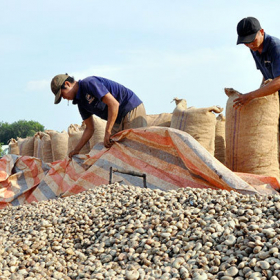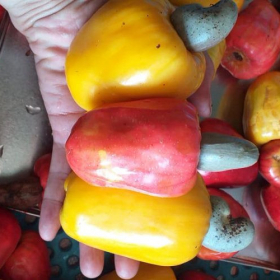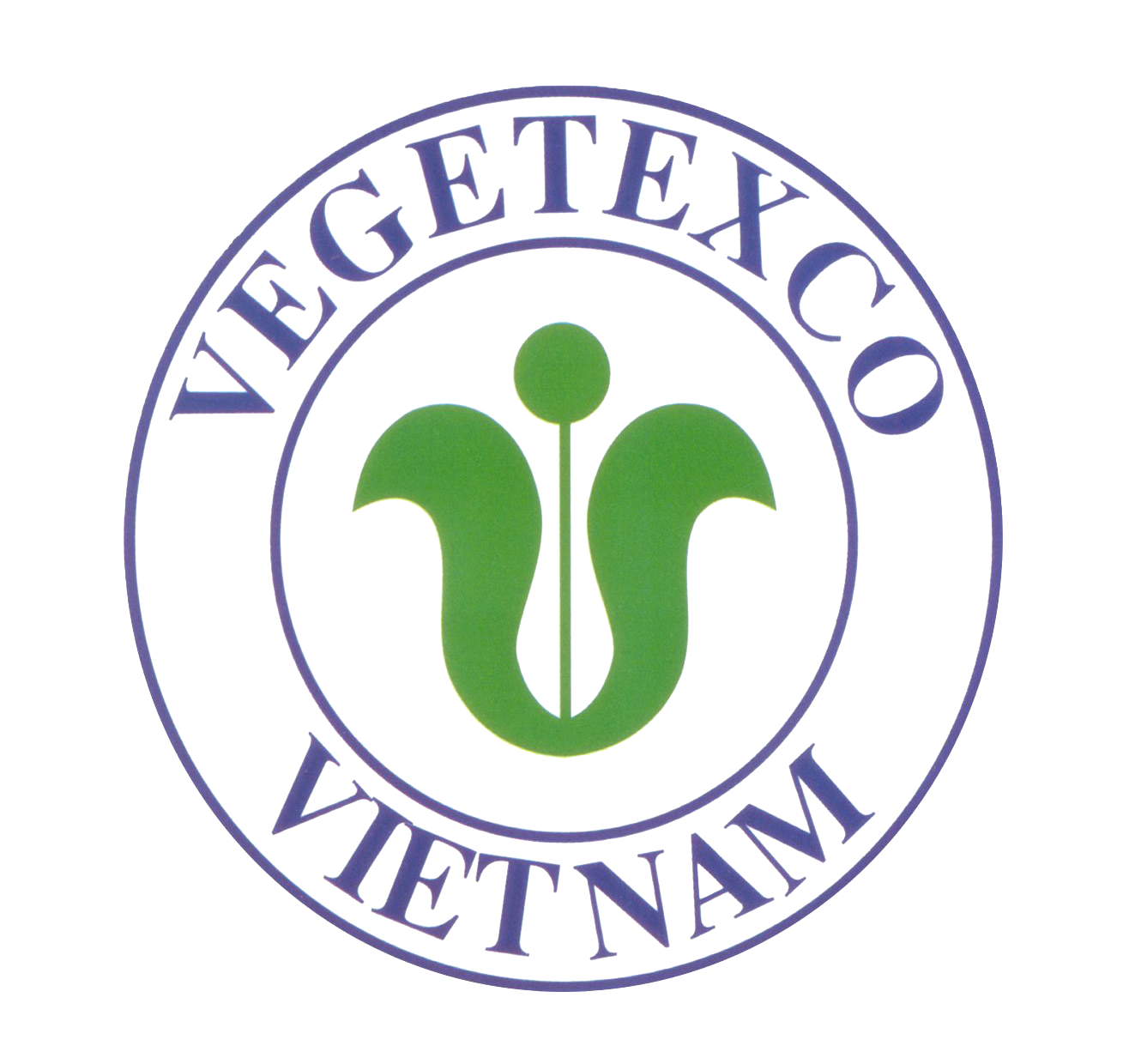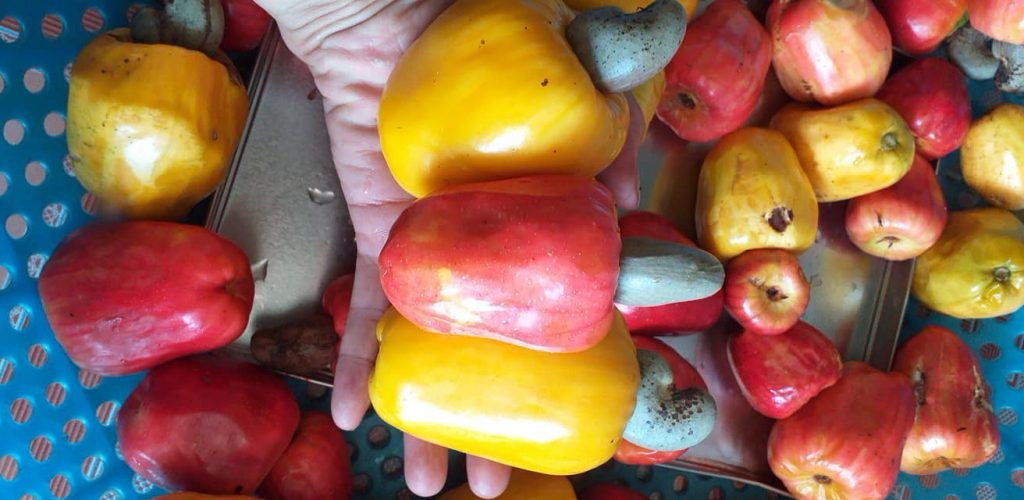INTRODUCTION OF CASHEWS: Cashews belong to the group of dry nuts with hard shell, soft and sweet taste, high in protein and some fat.
It is also known as a snack, and is a healthy food. Versatile and unique compared to other nuts. Full of essential nutrients for good health.
Overview of the cashew tree
The origin
Although it is now grown in many places, the origin of the cashew tree is from the northeastern region of Brazil. It was later brought to India in the 16th century by the Spanish, the Portuguese empire. At that time, they also brought cashew trees to their colonial countries, in the African region like Kongo or Mozambique.
Today’s commercial cashew trees are grown mainly in places where there is a lot of rain and wet weather. Throughout the year like in the Southeast region – Vietnam.
From India, the cashew tree then quickly spread throughout Southeast Asia: such as Vietnam, Indonesia, Cambodia, etc.
Currently, in addition to South American countries such as Brazil, cashew is grown mainly in India, and Southeast Asian countries (Vietnam, Indonesia, Thailand, Cabodia, East Timor, …). East and West Central African countries such as Côte d’Ivoire, Guinea-Bissau, Tanzania, Benin. It is quite surprising that in Australia, this tropical plant is also grown.
This plant is well suited to grow in areas with tropical climate conditions, at altitudes from sea level to 1,000mm, with an annual rainfall of 400 to 4,000mm.
INTRODUCTION OF CASHEWS DESCRIPTION OF CASHEWS
What is also known as “Pearl peach”: is a long-term industrial plant, scientifically known as Anacardium occidentale. Belongs to the nut family (Anacardiaceae), the same family as the mango tree and the pistachio tree. The cashew tree is an evergreen, fast-growing tree that can reach a height of 20 m. But the usual adult height is between 7 and 12 m.
Cashew trees are plants with hermaphroditic and male flowers, growing on the same tree and on the same stalk. Leaves alternate, short petioles. The flowers are small, purple or white with a mild fragrance.
INTRODUCTION OF CASHEWS
There is a fact that not everyone knows about the opposite. This is a dry fruit, not self-opening, kidney-shaped, about 2 to 3 cm long, hard outer shell, concave face. The fruit stem is enlarged, pear-shaped or peach-shaped, red or yellow.
It is because of that point that we, even perennial cashew growers, often think that the bulging stem is the fruit, and the attached fruit is the seed. Hence the name of the seeded peach (that is, the peach with the seed outside the left).
Therefore, many people often mistake peaches (cashew) for gymnosperms. But cashew nut (cashew) is exactly angiosperm. Kidney-shaped seeds, rich in fatty oils.
False fruits (fruit stalks) are rich in vitamin C. Can be eaten fresh, or pressed for fermentation to make light wine, fermented beverage. However, you should not eat a lot of fresh fruit because it causes thrush.
INTRODUCTION TO CASHEW NUTS
Cashew kernels are very tasty and nutritious. It has been commonly used as a snack/snack for centuries.
Cashew kernels are an important ingredient in confectionery, and an ingredient for cooking dishes, especially in Asian cuisine. Cashew kernels are also used as an integral ingredient in chocolates, cookies and ice cream.
In recent years, cashew milk has become a popular beverage. Lactose-free alternative to cow’s milk for those with lactose intolerance.

The benefits in the kernel
Cashew is one of the most commonly used nuts in the world. Cashew kernels contain many healthful micronutrients and minerals, such as phosphorus, copper and magnesium, which are not usually found in other foods.
Compared to other nuts, cashews and pistachios contain the lowest fat content.
About 80% of the fat in cashew kernels is unsaturated fat. Helps maintain healthy cholesterol levels.
Cashew kernels are also rich in active ingredients such as tocopherols and phytosterols. Has the effect of supporting the enhancement of oxidation and metabolism in cells.
The outside of the cashew kernel is a thin silk shell and the outermost is a very hard shell. The middle of the hard shell contains an inedible phenolic oil, also known as cashew shell oil (CNSL).
Cashew shell oil is widely used in industry, due to its ability to polymerize and reduce friction.
Raw cashew nuts in the shell are hanging below the fake, edible fruit called “cashew apple”. When ripe, cashew fruit has a very high vitamin C content,
Can be eaten raw, mixed with vegetables in salads or processed into fruit juice. Cashew juice can be distilled to produce alcoholic beverages, but it is not yet common.
Cashew industry
Cashew kernel production in the world is always stable, at between 470,000 and 580,000 tons annually. According to the formula, from 4.2 tons of raw cashew nuts, you will get 1 ton of cashew kernels.
India is the country that grows the most cashews, so it is not difficult to understand when India is at the top in terms of kernel production. With a figure of 150,000 to 190,000 tons, followed by Ivory Coast and Vietnam. With output reaching 70,000 to 95,000 tons. Brazil ranks next, with production ranging from 40,000 to 60,000 tons of kernels per year.
In the 2017/2018 season, according to the World Cashew Council (GCC). Global production is estimated at 7.4 million tons of fresh cashews, equivalent to about 3,322 million tons of raw cashews.
Production increased in most cashew-growing countries, such as India or Ivory Coast. But decreased in Vietnam and Cambodia due to the impact of crop failure due to weather.

However, over the past 10 years, Vietnam is still the world’s number 1 producer and exporter of cashew kernels. India is the second largest exporter, in terms of production, Ivory Coast ranks second.
Our biggest markets for cashew kernels are the US, the Netherlands and China.
The prospect of cashew consumption in the future, medium and long term will continue to increase steadily because of the health benefits, which this nut brings, this is also a great opportunity for Vietnam to develop the cashew production and processing industry. .
Things that are appreciated
International Nut and Dried Fruit Council (INC). The global dry nuts market is now worth $30 billion per year. In which, the leading is cashew, with the proportion expected to increase to 28.91% by 2021, ranked second is walnut.
Asia – Pacific will then lead the market. By geographical area, it accounts for 92.62% of the market for nuts and seeds.
Brief description of the formation of opposites
Cashew flowers are cross-pollinated, about a week after being pollinated. Small green seeds with false fruit begin to appear, the seeds are then quite soft. Seeds grow rapidly until they reach about 80% of their usual size.
The fruit then begins to grow larger, into an apple-like shape, after the seed has reached its full size.
When green, cashews have a thin green skin. And when ripe it turns red or yellow and has a characteristic aroma.


At that time, the shell of the seed will become increasingly hard and turn gray and the cashew kernel will grow inside this shell. When ripe, the cashew nut along with the seed will fall to the ground.
INTRODUCTION TO CASHEAT HEARING SUMMER
The global harvest season is not the same. In the northern hemisphere, cashew trees flower from December to April, and from June to December in the southern hemisphere. With the highest concentration of flowering from September to November.
The maturation of seeds and fruits, from pollination, lasts from 2 to 3 months. Depending on the cultivar, the health of the tree and the climatic conditions, in the development of the cashew fruit.
Cashew harvesting takes place in sunny weather, and when the fruit is ripe. During the period from March to 4 months, from the time of leaf fall, there are 3 to 4 periods of flowering and fruiting. So the harvest season is long.
When falling, the seeds and the fruit stick together, so the farmer separates the fruit, taking only the seeds. Dry the seeds in the sun for 2-3 days. And it is transported to processing plants to remove the shells and get the kernels.
Areas with the same latitude will generally have similar crops. Countries located north of the equator such as Vietnam, India, Cambodia and West Africa. The harvest will be from February to June of the solar calendar. Countries south of the equator, such as East Africa and Brazil. There is a harvest from September to February next year.
Note when collecting or adjusting
Contrary to that, although it looks quite nice and looks delicious. But when harvesting, people only take the seeds, not the fruit. If there is, it is also very little, because the cashew fruit is acrid and sweet and sour, not for long. When falling from the tree, the fruit is damaged. The water from the cashew fruit, when it sticks to light-colored clothes, will turn black and cannot be washed.

